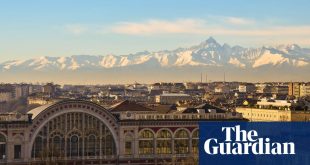“Every day I’m here, the sky and the sea are different,” says Anastasia Kharchenko, as an incessant drizzle patters on our umbrellas. “Sometimes you can’t even see the horizon because it’s so foggy, but in certain months the colours are just breathtaking.”
We’re standing on a grassy bluff above the town of Étretat on Normandy’s wind-sculpted Alabaster coast, its ragged chalk cliffs looking out into the Channel’s wild waters. Kharchenko is the head of cultural partnerships at the Jardins d’Étretat, a collection of intricately designed gardens that twist and curl down the hillside, dotted with quirky neo-futurist art installations. I apologise for bringing the grim English weather, as we look toward Étretat’s famous chalk arch and needle rock formations, extending from the cliffs like an arm leaning lazily into the raging waves below.
Claude Monet was a regular visitor here in the late 19th century and painted this dramatic coast just north of Le Havre over 100 times, precisely because these capricious weather conditions added so much atmosphere to his work. But while Monet and the rest of the impressionists were famous for their ethereal depictions of outdoor life here and in the genteel Normandy countryside, their work was seen together for the first time, 150 years ago, inside a Paris photography studio.
Disillusioned by the haughty traditional tastes of the Paris Salon, this band of artistic revolutionaries (which included Monet, Renoir, Degas and Cézanne) held their pioneering impressionist exhibition in April 1874. This year the Normandie Impressioniste 2024 festival – beginning 22 March – is hosting a range of events to mark the 150th anniversary of this landmark moment in art, with shows in coastal hotspot Deauville, Caen and many more across the region.
One of the works on display in 1874 was Monet’s Impression, Sunrise, a hazy loosely brushed depiction of the industrial port of Le Havre with a red morning sun reflecting on the water. Painted in 1872, it’s considered the first impressionist painting and became notorious largely thanks to condescending remarks by critic Louis Leroy, who unwittingly coined the term “impressionism” in a review published in the magazine Le Charivari on 25 April 1874: “Impression, I was certain of it. A preliminary drawing for a wallpaper pattern is more finished than this seascape.”
Monet grew up in Le Havre, and at first sight the modern city is anything but the dreamy cradle of impressionism one might picture. After taking a two-hour train west from Paris, I emerge from Le Havre’s station into the stocky and expansive Cours de la République. The tram to my hotel glides along the wide Boulevard de Strasbourg, flanked by an orderly mass of concrete apartments – the result of earlier buildings being obliterated by allied bombs targeting Nazi positions in September 1944. After the the second world war, architect and master of concrete Auguste Perret was charged with rebuilding Le Havre quickly and cheaply.
By the time Perret’s work was complete in the 1960s, the city’s stark grid of blocky streets forming the new centre ville led to Le Havre being cruelly dubbed in some quarters “Stalingrad-on-Sea”. But context is everything, and the longer I spend here, the more distinct and unique it feels. Nowhere I’ve seen in France looks quite like this. Its straight lines and orderly feel hold a strange charm, not too dissimilar to some Japanese cities, and its modernist appearance was eventually recognised by Unesco in 2005.
“Here, we say that Normandy is the birthplace of impressionism,” says my guide Lise Legendre, as we stroll the sea-sprayed boardwalk of Le Havre’s Saint Adresse neighbourhood, where Monet lived and along which fixed panels showing 19th-century impressionist works make for fascinating comparisons with the current landscape.
“But in order to become famous and to live from their art, they could not do that here,” Legendre says. “They had to go to Paris. That is how we link Normandy and Paris. We’re being very diplomatic.”
Paris was the dream, but Monet found himself and his style here. Hillside houses tumble down on to this corner of Le Havre’s wavy pebble beach, and glass-fronted bistros preparing for the summer season line the boardwalk. Murky silhouettes of container ships edge glacially along the horizon, waiting patiently to enter the port. Back in town, the Musée d’Art Moderne (MuMa), is preparing an intriguing exhibition, opening in May, exploring the relationship between impressionism and the sepia-toned formative years of 19th-century photography, and how those images freed up the artists to move away from true depictions of the world around them.
Natural light pours in from MuMa’s grand floor-to-ceiling windows, and the sunlight flaring across works by Renoir and Pissaro feels fitting for a museum with the largest impressionist collection outside Paris. In this form, light is a celebration.
“Impressionist paintings are part of my childhood,” says new MuMa director Géraldine Lefebvre who, rather conveniently, grew up on Le Havre’s rue Claude Monet. I ask her why the work of Monet, Renoir, Pissarro and co still resonates after 150 years. “Because they’re daily life paintings,” she says. “They’re full of life, colours, atmospheres. You can feel the landscape. Maybe they’re not intellectual, but they’re paintings that people can approach and understand.”
Monet’s obsessive nature took him along the winding banks of the Seine to Rouen, a cartoonishly pretty city strewn with pastel-coloured half-timbered townhouses and notable for the soaring charcoal-black spire of its tri-tower cathedral – France’s tallest at 151 metres. He painted the Gothic cathedral’s intricate facade 28 times in various light conditions, with the ghostly series becoming one of his most admired. And from 24 May, American artist Bob Wilson’s Cathedral of Light show will splash the facade every summer evening, soundtracked by music from Philip Glass and words by Maya Angelou.
For now though, it’s a surprisingly balmy March afternoon, with T-shirt-wearing tourists lounging on permanent wooden deckchairs outside. I wander through Rouen’s zigzagging medieval streets to the Musée des Beaux-Arts, where another exhibition is about to open by one of Normandy’s more surprising residents.
David Hockney has lived around here since 2019 and his Normandism exhibition is a blast of gaudy green landscapes and playful iPad portraits of his friends and loved ones. It’s free to enter and runs from this month until 22 September, and its place next door to masterpieces by Monet and co is inspired.
France’s biggest impressionism exhibition opens at Paris’s Musée D’Orsay later this month (Paris 1874 Inventing Impressionism), but the Seine and Normandy may leave a greater mark, whatever the weather.
The trip was provided by Normandy Tourism. Normandy Impressionist festival begins on 22 March. Hôtel and Spa Vent d’Ouest in Le Havre has doubles from €115 room-only. Hôtel de Dieppe 1880 in Rouen has doubles from €127 B&B. Accommodation in Paris was provided by Hôtel Léopold, which has doubles from €154 B&B. Direct trains to Le Havre and Rouen run every hour from Paris Gare Saint Lazare.
 Top Naija News: Nigerian News, Breaking News Nigeria and World News Top Naija News is a daily news publication in Nigeria, delivering the latest breaking news in Nigeria and around the world.
Top Naija News: Nigerian News, Breaking News Nigeria and World News Top Naija News is a daily news publication in Nigeria, delivering the latest breaking news in Nigeria and around the world.



